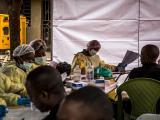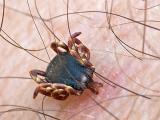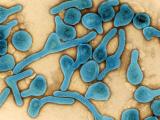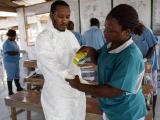Aug 20, 2007 (CIDRAP News) The hunt for the vector responsible for spreading Marburg hemorrhagic fever took global health experts wearing protective gear to the mine entrances in a remote Ugandan forest last week, the World Health Organization (WHO) recently reported.
Their mission is to trap bats, which are suspected as the source of a recent Marburg outbreak that killed a Ugandan miner in mid July and is thought to have sickened one of his coworkers, according to recent WHO reports. The WHO said there may be as many as three more suspected cases that have been linked to the mine, located in the western part of the country.
Lab tests recently confirmed the Marburg virus infection in blood samples from both the dead miner and one of his close contacts, according to an Aug 14 WHO report.
Christine McNab, a WHO spokesperson, said in a weekly WHO podcast that, of the seven known recent Marburg outbreaks, all but one occurred in Africa. She said the latest outbreak was contained.
Experts hope that identifying a vector for the disease will lead to the development of treatment or a vaccine, as well as new tactics for stopping virus transmission.
Marburg, a viral hemorrhagic fever similar to Ebola, causes fever and weakness, as well as severe gastrointestinal symptoms, severe chest pain, sore throat, and cough, according to the WHO. Since the disease was first documented in 1967, outbreaks have been rare. The last major Marburg outbreak occurred in Angola from October 2004 to July 2005; of 252 confirmed cases, 227 were fatal.
The mine where scientists are working is about 186 miles from Uganda's capital Kampala. Working with mist and harp nets, they trap the bats at the mouth of the mine as the animals leave after dusk to seek food and water, the WHO report said. The scientists' goal is to catch 100 bats a day until they collect about 1,000.
Two bat species have been found in the mine so far, the WHO said: Rousettus aegyptiacus (a fruit bat) and Hipposideros species (an insect eater). About 50 to 90 miners work at the site, which reopened last January, the WHO said, adding that about 5 million bats live in and around the mine.
After the bats are caught, they are taken to a nearby field laboratory where researchers immediately take blood and organ samples that will be used to examine for Marburg virus antibodies, the WHO reported. The samples are preserved in liquid nitrogen and shipped to labs at the US Centers for Disease Control and Prevention and the National Institute of Communicable Diseases in South Africa.
See also:
Aug 17 WHO report on bat study
WHO podcast on bat study
Aug 14 WHO statement on Marburg case
Aug 3 CIDRAP News story "Marburg fever case confirmed in Uganda"

















